
The History of Scagliola by Richard Feroze
Menu

For Catholic Europe, religious architecture in the second half of the 1500s was moving in the same grandiose and opulent direction as its secular counterpart, albeit for different reasons. The monopoly of the old Church had been irretrievably broken by the nonconformist teachings of Martin Luther and those who came after him. A wholesale examination and renewal was needed if the growth of Protestantism was to be reversed, or at least held in check. The Catholic response, known as the Counter Reformation, was set in motion by the Council of Trent. It convened over three separate periods between 1545 and 1563, during which time Europe’s senior Catholic luminaries debated and decreed on all aspects of religious doctrine and practice, including the appearance and function of churches.
The violent Protestant iconoclasm, which had seen pre-Reformation churches and abbeys stripped of their sacred art and treasure (and in many cases their roofs), had dismayed the Catholic Church. Its response was to initiate a major programme of church-building and renovation, and to make its places of worship more sumptuous than ever. Art and illusion were employed to illustrate the Christian story and impress its truth on congregations; expensive materials were used to overwhelm the senses and give a vision of the glory to come. This was one of the ways in which Catholicism hoped to maintain and strengthen the faith of those souls who still adhered to the old religion: and to win back the many who had been lost to the heresy of Luther and Calvin.
The Roman Church had always believed that both it and the saints had a God-given power to intercede with the Almighty on behalf of the faithful; this was one of the major points of disagreement with the reformed churches. The Council of Trent reinforced the doctrine of Intercession and actively encouraged it. In practical terms, this led to an increase in the decoration and furnishing of side-chapels, where prayers and masses could be offered up to specific saints and members of the Holy Family, often in the presence of a venerated relic. The decoration of these chapels was a popular way for confraternities and wealthy individuals to simultaneously demonstrate their religious patronage and seek help in the afterlife. In the process they commissioned some of the world’s most treasured paintings and sculptures.
Following the example of the papal chapels in Santa Maria Maggiore in Rome (see Chapter 3), polished marble became widely used in the enrichment of side-chapels and altars; in addition to floors and walls, it was an ideal material for handrails and balustrades, and of course altar fronts. For the most costly of these, inlaid Pietre Dure slabs were commissioned, bearing religious symbols and images. The display of marble, much of which had survived from ancient times, recalled on the one hand the eternal city, but on the other the triumph of Christianity over pagan Rome; its natural – and therefore God-given – colours were full of religious symbolism: blue for the Virgin, red for the blood of Christ, white and gold for the Trinity. Coloured marble could be used to depict the many different symbols of Catholic belief. Some of these were clear references to the passion of Christ, while others, such as certain flowers, birds and plants, symbolised specific Christian virtues.
The Catholic Church had no difficulty in accepting scagliola as an appropriate and practical substitute for marble; there were so many situations where cost and accessibility ruled out the real thing. Secular elites might see the material as a prestigious and ingenious artificio (and one which initially they tried to reserve for their own exclusive use); but for the Church authorities it was ‘il marmo dei poveri’ (poor man’s marble), and they allowed it to be commissioned extensively.
The contribution that scagliola has made (and continues to make) to church decoration is arguably one its greatest achievements. This will be covered in detail in the chapters devoted to religious interiors.
Coloured marble in religious settings. Left: Holy water stoup, St. Peter’s Basilica Rome (early 18th. C). Centre: Marble detail from monument to Pope Gregory XV in the Ludovisi Chapel, Sant.Ignazio, Rome (first quarter 18th. C) Right: High altar with solid green inner and inlaid green and white outer marble columns. The latter imitate patterned material. (c. 1730), I Gesuiti, Santa Maria Assunta, Venice. (Click on images to enlarge)
References:
Alastair Laing: Part IV Central and Eastern Europe in Baroque and Rococo, Architecture and Decoration ed. Anthony Blunt, Ware 1988 pp.167-176
Diarmaid MacCulloch: Reformation: Europe’s House Divided, Penguin Books Ltd. 2004
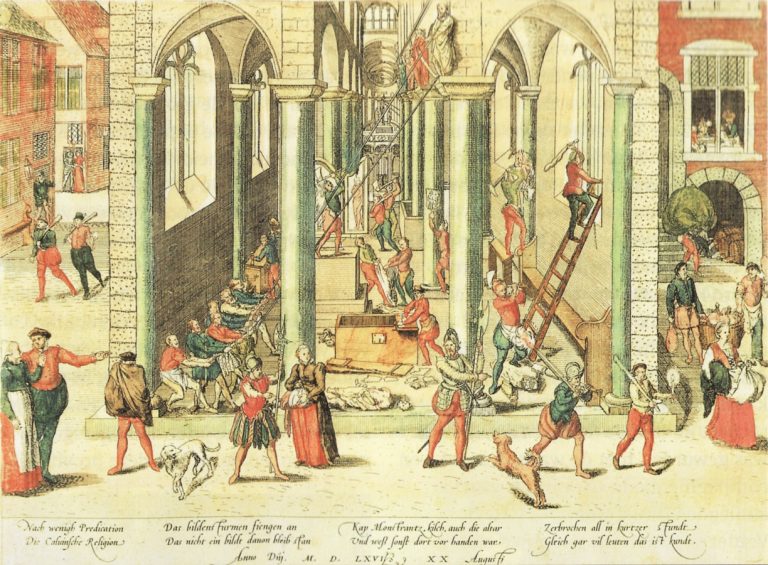
Iconoclasts at work in the Church of Our Lady in Antwerp, 20th August 1566. Coloured print by Franz Hogenberg. (Hamburg, Kunsthalle. Photo through Wikimedia Commons).
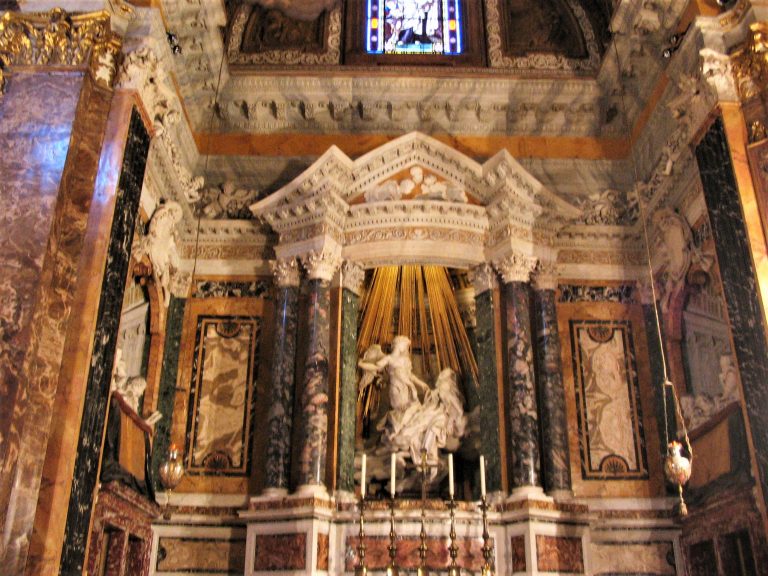
Bernini’s Cornaro Chapel built around his famous ‘Ecstasy of St. Teresa’ (1647-52). Members of the Cornaro family witness the event from adjacent loges. Santa Maria della Vittoria, Rome.
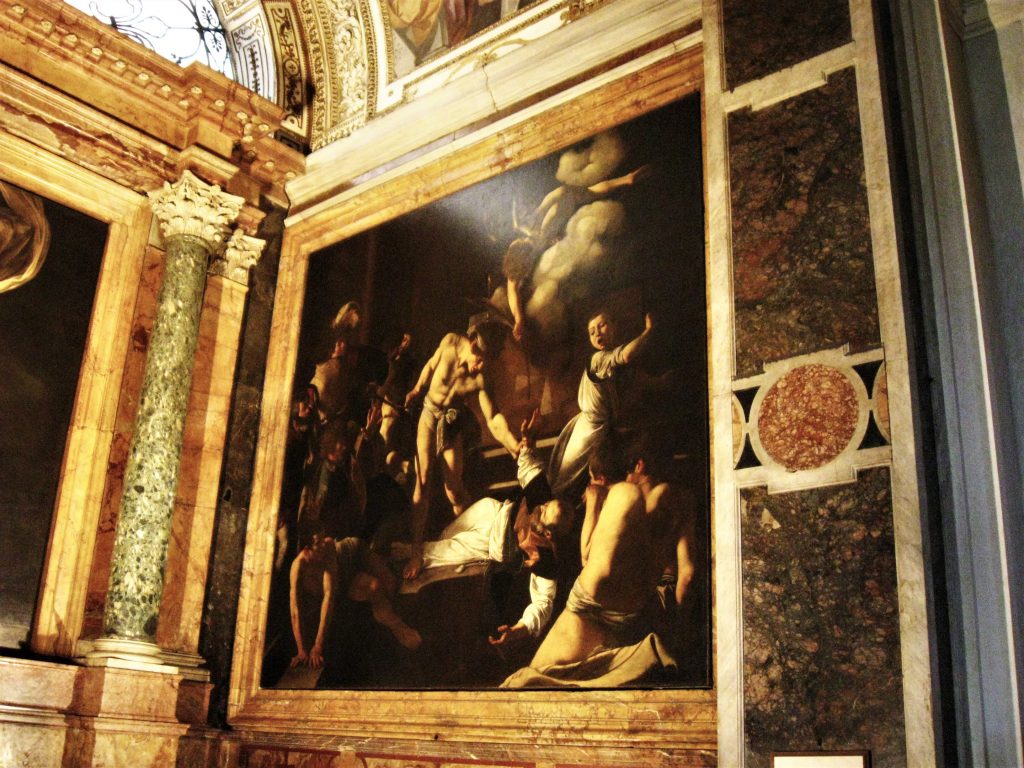
The Contarelli Chapel: Caravaggio’s Martyrdom of St. Matthew (1600) set within marble framing, San Luigi dei Francesi, Rome.
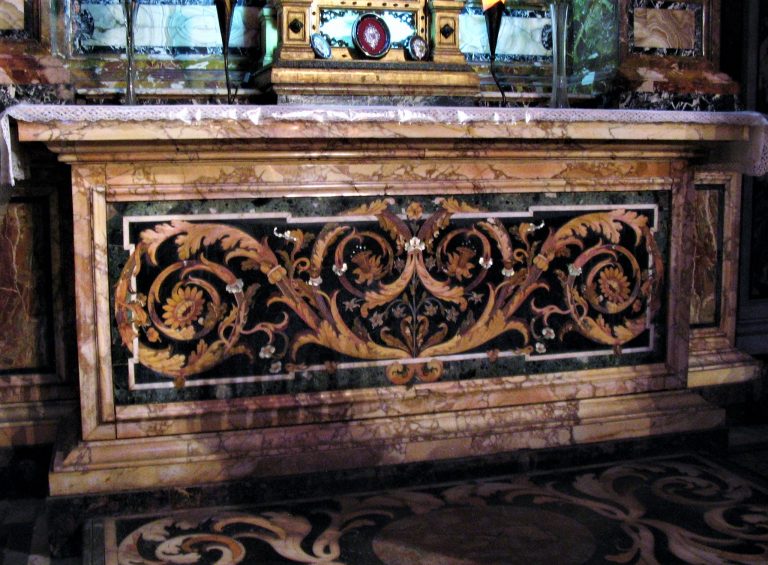
Pietra Dure altar front, Santa Maria della Vittoria, Rome (2nd half 17th C.?).
For Catholic Europe, religious architecture in the second half of the 1500s was moving in the same grandiose and opulent direction as its secular counterpart, albeit for different reasons. The monopoly of the old Church had been irretrievably broken by the nonconformist teachings of Martin Luther and those who came after him. A wholesale examination and renewal was needed if the growth of Protestantism was to be reversed, or at least held in check. The Catholic response, known as the Counter Reformation, was set in motion by the Council of Trent. It convened over three separate periods between 1545 and 1563, during which time Europe’s senior Catholic luminaries debated and decreed on all aspects of religious doctrine and practice, including the appearance and function of churches.

Iconoclasts at work in the Church of Our Lady in Antwerp, 20th August 1566. Coloured print by Franz Hogenberg. (Hamburg, Kunsthalle. Photo through Wikimedia Commons).
The violent Protestant iconoclasm, which had seen pre-Reformation churches and abbeys stripped of their sacred art and treasure (and in many cases their roofs), had dismayed the Catholic Church. Its response was to initiate a major programme of church-building and renovation, and to make its places of worship more sumptuous than ever. Art and illusion were employed to illustrate the Christian story and impress its truth on congregations; expensive materials were used to overwhelm the senses and give a vision of the glory to come. This was one of the ways in which Catholicism hoped to maintain and strengthen the faith of those souls who still adhered to the old religion: and to win back the many who had been lost to the heretical teachings of Luther and Calvin.

Contarelli Chapel: Caravaggio’s Martyrdom of St. Matthew (1600), set within marble framing, San Luigi dei Francesi, Rome.
The Roman Church had always believed that both it and the saints had a God-given power to intercede with the Almighty on behalf of the faithful; this was one of the major points of disagreement with the reformed churches. The Council of Trent reinforced the doctrine of Intercession and actively encouraged it. In practical terms, this led to an increase in the decoration and furnishing of side-chapels, where prayers and masses could be offered up to specific saints and members of the Holy Family, often in the presence of a venerated relic. The decoration of these chapels was a popular way for confraternities and wealthy individuals to simultaneously demonstrate their religious patronage and seek help in the afterlife. In the process they commissioned some of the world’s most treasured paintings and sculptures.

Bernini’s Cornaro Chapel built around his famous ‘Ecstasy of St. Teresa’ (1647-52). Members of the Cornaro family witness the event from adjacent loges. Santa Maria della Vittoria, Rome.
Following the example of the papal chapels in Santa Maria Maggiore in Rome (see Chapter 3), polished marble became widely used in the enrichment of side-chapels and altars; in addition to floors and walls, it was an ideal material for handrails and balustrades, and of course altar fronts. For the most costly of these, inlaid Pietre Dure slabs were commissioned, bearing religious symbols and images.
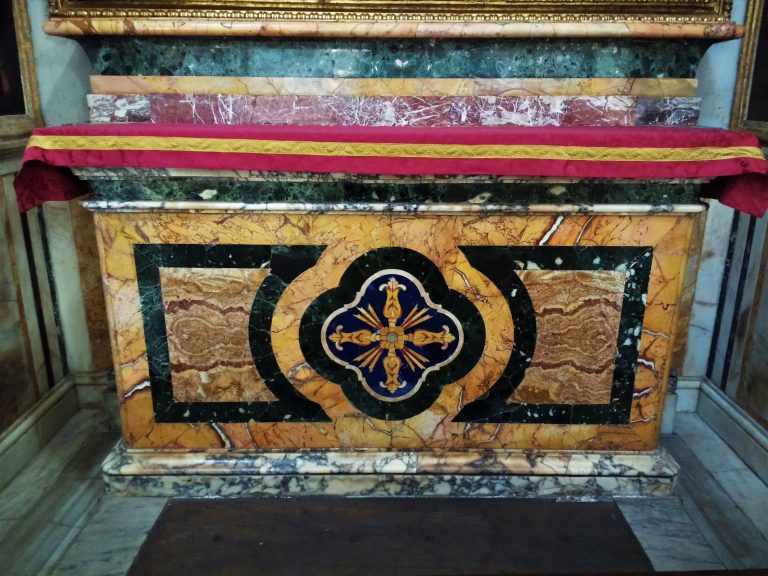
Pietre Dure altar front, Santa Maria della Pace, Rome (c. 1550).

Pietra Dure altar front, Santa Maria della Vittoria, Rome (2nd half 17th C.?).
The display of marble, much of which had survived from ancient times, recalled on the one hand the eternal city, but on the other the triumph of Christianity over pagan Rome; its natural – and therefore God-given – colours were full of religious symbolism: blue for the Virgin, red for the blood of Christ, white and gold for the Trinity. Coloured marble could be used to depict the many different symbols of Catholic belief. Some of these were clear references to the passion of Christ, while others, such as certain flowers, birds and plants, symbolised specific Christian virtues.
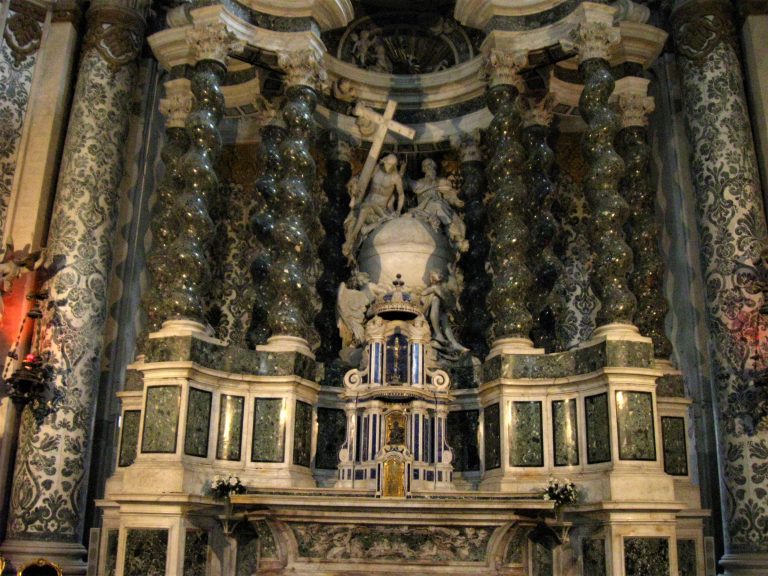
Main altar with solid green and inlaid green and white marble columns. The latter imitate patterned material (c. 1730). I Gesuiti, Santa Maria Assunta, Venice.
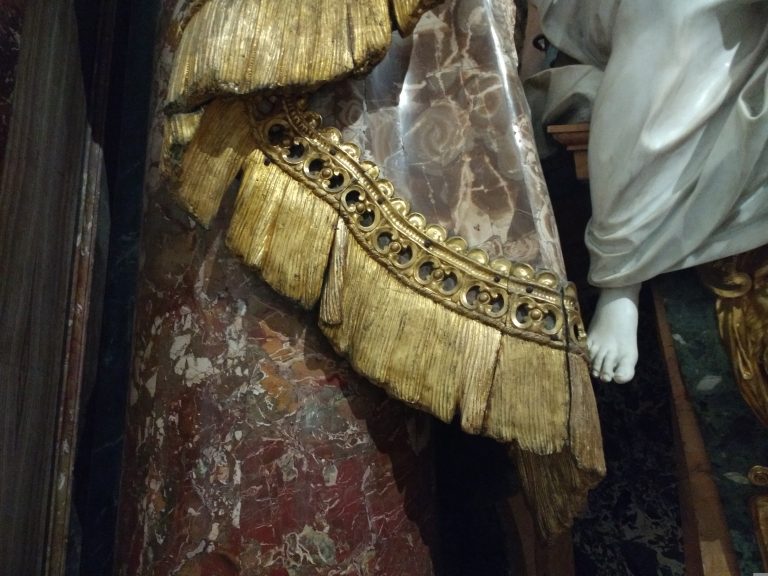
Marble details from monument to Pope Gregory XV in the Ludovisi Chapel (first quarter 18th. C), Sant.Ignazio, Rome.
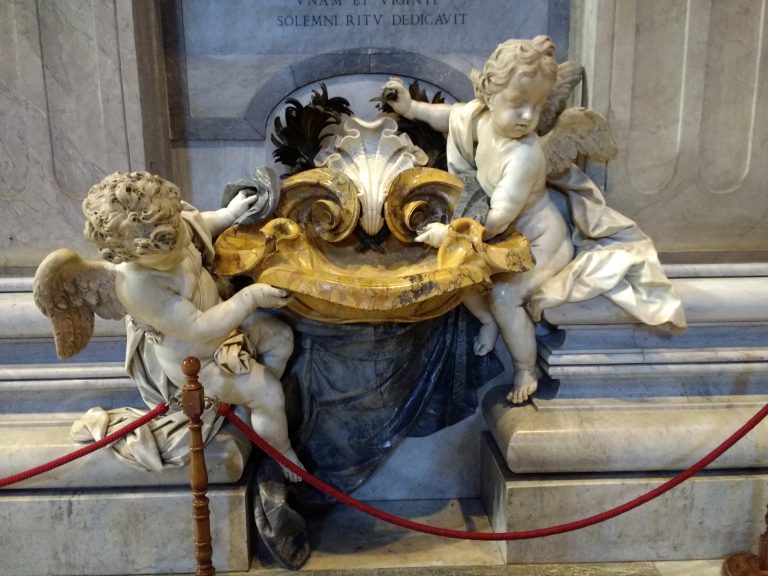
Holy water stoup (early 18th. C), St. Peter’s Basilica Rome.
The Catholic Church had no difficulty in accepting scagliola as an appropriate and practical substitute for marble; there were so many situations where cost and accessibility ruled out the real thing. Secular elites might see the material as a prestigious and ingenious artificio (and one which initially they tried to reserve for their own exclusive use); but for the Church authorities it was ‘il marmo dei poveri’ (poor man’s marble), and they allowed it to be commissioned extensively.
The contribution that scagliola has made (and continues to make) to church decoration is arguably one its greatest achievements. This will be covered in detail in the chapters devoted to religious interiors.
References:
Alastair Laing: Part IV Central and Eastern Europe in Baroque and Rococo, Architecture and Decoration ed. Anthony Blunt, Ware 1988 pp.167-176
Diarmaid MacCulloch: Reformation: Europe’s House Divided, Penguin Books Ltd. 2004